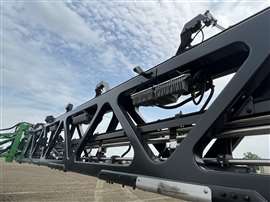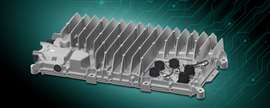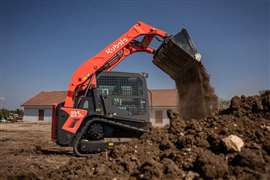Read this article in Français Deutsch Italiano Português Español
John Deere Electronics: Technology moves beyond ag applications
11 June 2025
When you mention the name John Deere, many people may envision green tractors in the field or yellow iron on a jobsite. But the company also supplies products much smaller in scope that are just as rugged and as impactful in their own right.
 John Deere Electronics’ portfolio includes inverters (shown), displays, controllers and more. (Photo: Becky Schultz)
John Deere Electronics’ portfolio includes inverters (shown), displays, controllers and more. (Photo: Becky Schultz)
John Deere Electronics offers a portfolio that includes inverters, displays, controllers, communications hardware (telematics modules), sensors and even ruggedized Ethernet switches. Also among its lineup are high-end compute platforms such as its Vision Processing Unit (VPU), which was an instrumental part of the company’s See & Spray product platform for the agricultural sector.
Now, the division has announced commercial availability of the high-performance VPU to OEMs across various industries, enabling the technology’s use in both on-highway and other off-highway applications.
Module components
The VPU is a module designed for rugged environments and advanced Computer Vision Machine Learning (CVML) applications. It is the core component behind John Deere’s See & Spray technology for precision agriculture applications.
The module offers a high GPU- and high CPU-capable platform that the company said enables OEMs in various industries to integrate vision-based automation into their own products.
 The Vision Processing Unit is a core part of John Deere’s See & Spray product platform for the ag industry. (Photo: Becky Schultz)
The Vision Processing Unit is a core part of John Deere’s See & Spray product platform for the ag industry. (Photo: Becky Schultz)
“This technology has been around in the passenger car industry for a while now but we’re seeing that grow more in the industrial areas,” said Jason Weishaar, manager of OEM sales, John Deere Electronics.
The module includes 12 ports for camera integration to enable comprehensive visual data capture, facilitating such applications as:
- Advanced vision systems for improved situational awareness across various vehicle and machinery types.
- Autonomous navigation, advanced robotics and real-time image and video processing, along with AI-driven quality control and inspection across a broad spectrum of industrial sectors.
The module is built to seamlessly interface with vehicles and machinery through industry-standard communication protocols, including CAN and Ethernet.
“What we’re doing is providing the vision processing unit and potentially some camera recommendations, and [the OEMs are] going to take it from there,” Weishaar said.
Currently, the company plans to offer a base software package that can be tailored to the application. Further customization – such as additional cameras, an Ethernet switch or other components – can be provided as needed.
“In the future, we plan to provide full technology stack solutions with multiple components – VPU, cameras, etc. – that would be designed to meet specific needs or functionality, such as obstacle detection. These solutions would also include the full suite of software needed to enable the solution,” Weishaar explained.
Rugged, simplified design
The VPU’s origin stems initially from a collaboration with and then subsequent acquisition of Blue River Technology by John Deere in September 2017. Its newest iteration was designed specifically for the rugged environments in which John Deere’s equipment operates.
 The highly ruggedized module is designed for advanced Computer Vision Machine Learning applications. (Photo: John Deere Electronics)
The highly ruggedized module is designed for advanced Computer Vision Machine Learning applications. (Photo: John Deere Electronics)
According to Nicholas Weisbeck, electronics systems module manager at John Deere, “We’ve engineered this module to perform in the harshest environments, focusing on robust thermal and vibration performance. Unlike others on the market, we’ve achieved this without liquid cooling or internal fans, relying on innovative air cooling and a rugged IP67-rated design.”
“Our true uniqueness in this area is our cooling technology,” Weishaar added. “Most of these high-compute modules either have a fan on them, or they’re liquid cooled or much more complex than what we have in place. We don’t require any active cooling. It’s all conductive… just airflow cooling across, which makes it more easily adopted into a lot of applications.”
This combination of ruggedness and innovative cooling technology results in “a highly reliable platform for cutting-edge CVML applications,” said Weisbeck, which will enable OEMs to bring advanced processing capabilities and greater autonomy to their products.
“We feel like there’s a broad range of applications where this could be used,” Weishaar stated. “It’s in the ag market already. I believe it could be used [in the] commercial vehicle space, and other off-highway type industrial applications could benefit from this type of technology. That’s our plan – to offer it to OEMs.”
Collaboration for high performance
At ACT Expo 2025, New Eagle, a provider of embedded software solutions and ECUs, introduced the Raptor High-Performance Compute Platform, a rugged GPU-enabled embedded controller built on a vision processing unit from John Deere.
The high-compute system will be the first GPU-enabled controller in the Raptor lineup, which the company said offers a path to deploy AI-driven control and vision applications at the edge. While the hardware is developed by John Deere, New Eagle is actively integrating the platform into the Raptor ecosystem, with support for model-based development workflows.
Learn more about the Raptor High-Performance Compute Platform as well as the relationship between New Eagle and John Deere in a future issue of Power Progress or at PowerProgress.com.
POWER SOURCING GUIDE
The trusted reference and buyer’s guide for 83 years
The original “desktop search engine,” guiding nearly 10,000 users in more than 90 countries it is the primary reference for specifications and details on all the components that go into engine systems.
Visit Now
STAY CONNECTED




Receive the information you need when you need it through our world-leading magazines, newsletters and daily briefings.
CONNECT WITH THE TEAM













